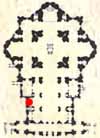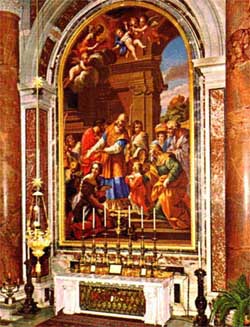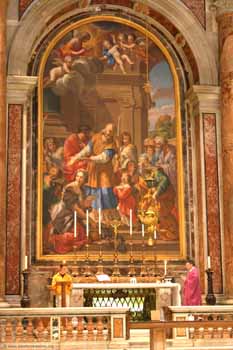| Grottoes
Vatican City Colonnade Saints Floorplan #2 |
| Altars
Monuments The History |
| Related
Sites St. Pius X Presentation of Mary |
|
The mosaic altarpiece is the Presentation of the Virgin Mary in the Temple by her parents. Below the altar is the body of St. Pius X (1904-1914), the last pope to be canonized. |
 |
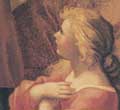 |
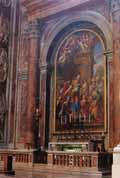 |
From:
'Guide to St. Peter's Basilica'
Before this altar was dedicated to St. Pius X, it was known as the altar
of the Presentation of the Virgin Mary in the Temple. She is portrayed
as a little girl joyfully going up the steps to the temple with her parents
Anne and Joachim.
Below the altar, is a crystal coffin containing the body of St. Pius X (1904-1914), "pauper et dives, mitis et humilis corde". The body is dressed in pontifical robes, while the face and hands are covered with silver. The world greatly admired his wisdom and firm government. He helped restore Christian life by issuing wise laws on the religious education of children, youths and adults. His catechism gives clear answers to many religious questions. He allowed young children to take Communion, promoted the practice of daily communion as a source of virtue and holiness, he reformed the liturgy in the Missal and Breviary as well as sacred music and Gregorian chant. He fought against and condemned modernism which is still the cause of many evils. He was, however, unable to convince the reigning monarch and heads of state of his era to avoid the conflict that would shed blood throughout Europe for four long years.
From:
'Seminarians Guide'
Under the altar the crystal casket contains the body of Pope Pius X. St.
Pius X (1904-1914) was a great Pope of the twentieth century who allowed
young children to receive communion, promoted daily communion, reformed
the missal, breviary, and canon law, and issued a catechism for the instruction
of children.
From
'St. Peter's - Guide to the Basilica and Square'
Then on the right is the Chapel of the Presentation, named after the marble
retablero over the main altar from a painting by Giovanni Francesco Romanelli
(1610-1662) of the Presentation of the Virgin. In the gilded bronze and
crystal casket beneath the altar is the body of St. Pius X (1904-1914),
clad in solemn papal robes.
From:
'St. Peter's Basilica - A Virtual Tour' by Our Sunday Visitor
Continuing on we reach the Presentation Chapel, the last in the Marian
cycle. Its mosaic decoration in fact concerns the prefigurations in the
Old Testament, referring to the gifts of the Virgin. The author of the
original drawings was C. Maratti, a master who, for the number of his
works present in the Basilica, was second only to Pietro da Cortona, the
undisputed leader of the painting school in Rome in the last decades of
the 17th century. Maratti was helped by his favorite pupil G. Chiari.
The mosaics, which are of good chromatic and decorative quality, were executed by F. Cristofari, Ottaviani and others. The vault shows the fall of Lucifer, in contraposition with the one on the other side depicting the coronation of the Queen of the Most High above the Choirs of Angels. On the corbels are Isaiah looking at the cloud, Joshua stopping the sun, Jael stabbing Sisera, Judith with the head of Holofernes.
In the lunettes are Mary, the sister of Moses, singing the freedom of the Israelites, Moses removing his sandals before the burning bush, Noah with his arc and the dove of peace, Aaron anointing the Holy Arc, Balaam showing Jacob's star, Gideon with the mystic fleece bathed in dew. In 1727 a mosaic copy by Cristofari of the Presentation of the Virgin Mary at the Temple by G. F. Romanelli, painted by this artist from Viterbo in 1622, was placed above the altar of the Chapel. This work replaced a deteriorated work by Passignano.
From:
'THE NEW SAINT PETER'S'
Next we approach the Cappella della Presentazione: over the altar is the
Presentation of Mary in the Temple, from an original by Romanelli. The
other lovely decorative works were done by the 18th century painter Carlo
Maratta. Under the altar is the body of Saint Pius X. To the right of
the altar is the place where the bodies of deceased Popes are kept until
their final burial. To the left is the monument of Pope Benedict XV (1914-1922),
a fine work by Pietro Canonica which attains a great effectiveness in
rendering the expression of the Pontiff's face in prayer. Opposite is
placed the large bronze bas-relief by Emilio Greco, portraying and developing
some themes of the pontificate of John XXIII already treated in the door
made for the Cathedral at Orvieto.
|
Early morning
mass at the |
